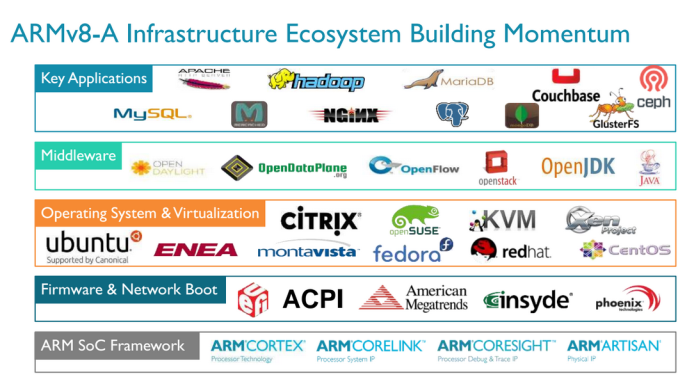ARM Challenging Intel in the Server Market: An Overview
by Johan De Gelas on December 16, 2014 10:00 AM ESTThe Evolving Server Market
The previous page might give you the impression that we do not give the ARM players a chance against mighty Intel. That is not the case, but we believe that the wrong arguments are often used. Intel's success was also a result of the huge amount of Windows desktop users that were enthusiastic about using their Windows knowledge in a professional environment. The combination of Windows NT and the success of the Pentium Pro was very powerful.
ARM also has such a "Trojan software horse" and it is called the Linux based cloud. We're not saying anything new when we say that cloud services have really taken off and that the Internet of Things will make cloud services even more important. Those cloud services have been creating a tsunami of innovation and are based on open source projects such as Hadoop, Spark, Openstack, MongoDB, Cassandra, good old Apache, and hundreds of others. That software stack is ported or being ported to the ARM software ecosystem.
But you probably knew that. Let's make it more concrete. Just a while ago we visited the Facebook hardware lab. Being a server hardware enthusiast, we felt like a child in a large toy store. Let me introduce you to Facebook's Open Vault, part of the the Open Compute Project:
... is a simple and cost-effective storage solution with a modular I/O topology that’s built for the Open Rack. The Open Vault offers high disk densities, holding 30 drives in a 2U chassis, and can operate with almost any host server.
Mat Corddry, director of hardware of engineering showed us the hardware:
The first incarnation of the "honey badger" micro server is based on Avoton. But nothing is stopping Facebook from using an ARM micro server in their Open Vault machines if it offers the same capabilities and is cheaper and/or lower power. As cheap storage is extremely important in the "Big Data" age, this is just one of the opportunities that the "smaller" ARM server SoCs have. But it also makes another point: they have to beat the Intel SoCs that are already known and used.












78 Comments
View All Comments
aryonoco - Wednesday, December 17, 2014 - link
I just wanted to thank you Johan De Gelas for this very insightful and interesting article.Hugely enjoyed reading it and your thoughts on the subject.
Good to see high quality content continue to be published at AT now that Anand has left.
JohanAnandtech - Wednesday, December 17, 2014 - link
aryonoco, Jann Thanks for letting me know. A good motivation to always push a bit harder to make sure I don't let my readers down :-).jann5s - Wednesday, December 17, 2014 - link
Thank you Johan, for writing this very interesting article!przemo_li - Wednesday, December 17, 2014 - link
Very well written walk through current and possible CPU/SOC parts.Will there be similar piece for software?
ARM (embedded) folks aren't famous for quality drivers/code.
It must change, so it will change. But for now such overview would be great!
bobbozzo - Wednesday, December 17, 2014 - link
Typo on page2:"(4 Slots x 8 DIMMs)" - change 8 to 8GB
Thanks
bobbozzo - Wednesday, December 17, 2014 - link
and page 4:"you will be able to choose between SoCs that have 100 Gbit Ethernet and 10GBit Ethernet."
should 100 be 40?
bobbozzo - Wednesday, December 17, 2014 - link
Page 12:"Most of them are the usual IPSec, TPC offloading engines"
Should that be TCP?
Also, are there still accelerators for AntiVirus engines and IDS/IPS search (there were some back in 2005).
Thanks
bobbozzo - Wednesday, December 17, 2014 - link
...I guess that's what the RegEx would be useful for.
However, not all IDS/IPS / A/V patterns use RegEx, and there are other means of acceleration.
eanazag - Wednesday, December 17, 2014 - link
Welcome back Johan.Glad to see you're still writing here. Good stuff in the article.
JKflipflop98 - Wednesday, December 17, 2014 - link
I simply don't get where this whole "microserver" thing is coming from.By the time you cluster up enough ARM processors to match the processing power of an Intel/AMD solution, you're burning just as much power and spent just as much money as you would have by using x86 in the first place. Except now you have to use some janky middleware solution because all your software is x86 and you're running on ARM cores.